
Urho Kaleva Kekkonen, often referred to by his initials UKK, was a Finnish politician who served as the eighth and longest-serving president of Finland from 1956 to 1982. He also served as prime minister, and held various other cabinet positions. He was the third and most recent president from the Agrarian League/Centre Party. Head of state for nearly 26 years, he dominated Finnish politics for 31 years overall. Holding a large amount of power, he won his later elections with little opposition and has often been classified as an autocrat.
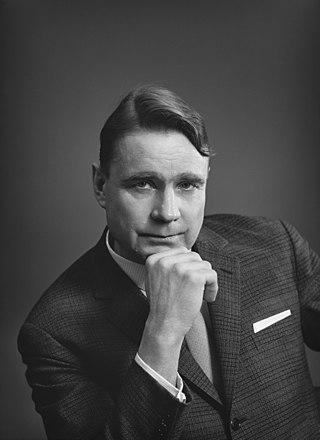
Mauno Henrik Koivisto was a Finnish politician who served as the ninth president of Finland from 1982 to 1994. He also served as the country's prime minister twice, from 1968 to 1970 and again from 1979 to 1982. He was also the first member of the Social Democratic Party to be elected as President of Finland.

The president of the Republic of Finland is the head of state of Finland. The incumbent president is Alexander Stubb, since 1 March 2024. He was elected president for the first time in 2024.
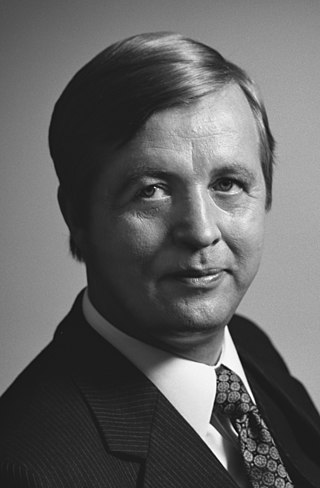
Taisto Kalevi Sorsa was a Finnish politician who served as Prime Minister of Finland three times: 1972–1975, 1977–1979 and 1982–1987. At the time of his death he still held the record for most days of incumbency as prime minister. He was also a long-time leader of the Social Democratic Party of Finland.
The National Coalition Party is a liberal-conservative political party in Finland.
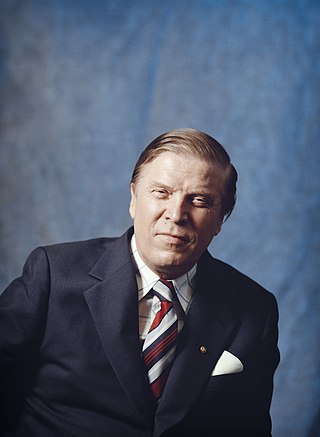
Johannes Virolainen was a Finnish politician and who served as 30th Prime Minister of Finland, helped inhabitants of Karelia, opposed the use of alcohol and created Mandatory Swedish in Finnish basic schools.
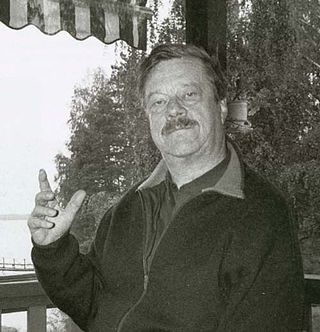
Kari Yrjänä Suomalainen was a famous Finnish political cartoonist, known as Kari. His cartoons appeared daily in Helsingin Sanomat from 1951 to 1991 and they became popular throughout the nation. While most of them comment on current politics, some are based on everyday life. Suomalainen received many awards for his work, including the National Cartoonist Society (US) award in 1959, Puupäähattu in 1984 and Pro Finlandia in 1989. He was also appointed honorary professor in 1977.

Paavo Matti Väyrynen is a Finnish politician who, in his long and eventful political career, has served, among other things, as Minister of Foreign Affairs from 1977 to 1982, and again from 1983 to 1987 and from 1991 to 1993. He is a former member of the Finnish Parliament who has represented the Seven Star Movement, the Citizen's Party and Centre Party. He left the Centre Party in 2023.

Ahti Kalle Samuli Karjalainen was a Finnish economist and politician. He was a member of the Agrarian League and served two terms as Prime Minister of Finland. He is, however, better known for his period as Minister of Foreign Affairs of Finland. Karjalainen is considered one of the most influential figures in post-war Finnish politics. Like President Urho Kekkonen, Karjalainen attached great importance to Finland's relationship with the Soviet Union, and was at one point considered to be Kekkonen's likely successor until alcoholism affected his later career.
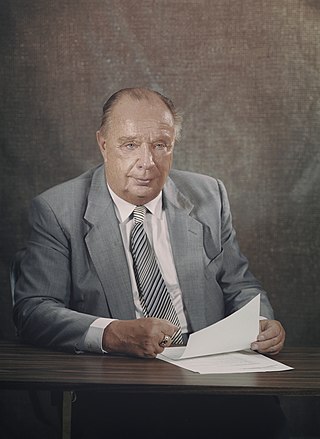
Veikko Emil Aleksander Vennamo was a Finnish politician. In 1959, he founded the Finnish Rural Party, which was succeeded by the True Finns in 1995. He had originally been the leader of a faction of the Agrarian League. When his opponent, Urho Kekkonen, was elected president of Finland, Vennamo broke off his Agrarian League affiliation. Vennamo was a member of Parliament in 1945–1962 and 1966–1987. He was also the director of the Agricultural ministry's Resettlement office in 1944–1959 and was responsible for the resettlement of the farmers evacuated from the ceded Karelia. Later he was a department director at the Board of Customs.

Tamminiemi is a villa and house museum located in the Meilahti district of Helsinki, Finland. It was one of the three official residences of the President of Finland, from 1940 to 1982. From 1956, until his death in 1986, it served as the residence of President Urho Kekkonen. Since 1987, it has been the Urho Kekkonen Museum. Tamminiemi is located in a park by the sea. Its floor area is about 450 square metres (4,800 sq ft); living quarters comprise the first two floors while the third floor is dedicated to office space.
Parliamentary elections were held in Finland on 21 and 22 September 1975.
Parliamentary elections were held in Finland on 18 and 19 March 1979.
Parliamentary elections were held in Finland on 20 and 21 March 1983. The elections were widely regarded as a "protest election" because, contrary to expectations, the major parties with the exception of the Social Democratic Party (SDP) performed poorly; the Liberal People's Party (LKP) lost all its seats in the Eduskunta, while the Finnish Rural Party (SMP) more than doubled its seat tally and the Greens won seats for the first time. The SMP's success was credited, at least in part, to voter distaste for some mainstream parties because of political scandals; no significant policy differences emerged in the election campaign. The SDP won 57 seats, the best performance by a party since World War II.

Two-stage presidential elections were held in Finland in January 1982. The public elected presidential electors to an electoral college on 17 and 18 January. They in turn elected the president. The result was a victory for Mauno Koivisto, the first member of the Social Democratic Party to be elevated to the country's highest post, and his election meant the full integration of Social Democrats into Finnish public life and an end to the postwar dominance of the Centre Party.

The Social Democratic Party of Finland is a social democratic and pro-European political party in Finland. It is the third largest party in the Parliament of Finland with 43 seats. Founded in 1899 as the Workers' Party of Finland, the SDP is Finland's oldest active political party and has a close relationship with the Central Organisation of Finnish Trade Unions. It is also a member of the Party of European Socialists, Progressive Alliance, Socialist International and SAMAK.

The first cabinet of Kalevi Sorsa was the 56th government of Finland. The cabinet's Prime Minister was Kalevi Sorsa. The cabinet was in office from 4 September 1972 to 13 June 1975.

The third cabinet of Kalevi Sorsa was the 62nd government of Finland. The majority government lasted from 19 February 1982 to 6 May 1983. The cabinet's prime minister was Kalevi Sorsa. The Finnish People's Democratic League disapproved of the government's decision to raise the country's defence budget, which led to a governmental crisis, which culminated in the FPDL being forced to resign from the government by the prime minister on 31 December 1982. As a result of the change, the Liberal People's Party joined the coalition and, together with the rest of the previous government, formed the Sorsa IIIb Cabinet.

The Independence Day Reception is an annual event organised by the President of Finland at the Presidential Palace in Helsinki on 6 December, Finland's Independence Day. Invitations are sent to all members of parliament and other representatives of the national and municipal governments, the ambassadors to Finland, representatives of NGOs, important business people, and people who distinguished themselves during the year in the arts, sports, sciences, and other fields.
Taisto Tähkämaa is a Finnish Centre Party politician who served at the Parliament and held various cabinet posts, including minister of defense and minister of agriculture and forestry in the 1970s and 1980s.













